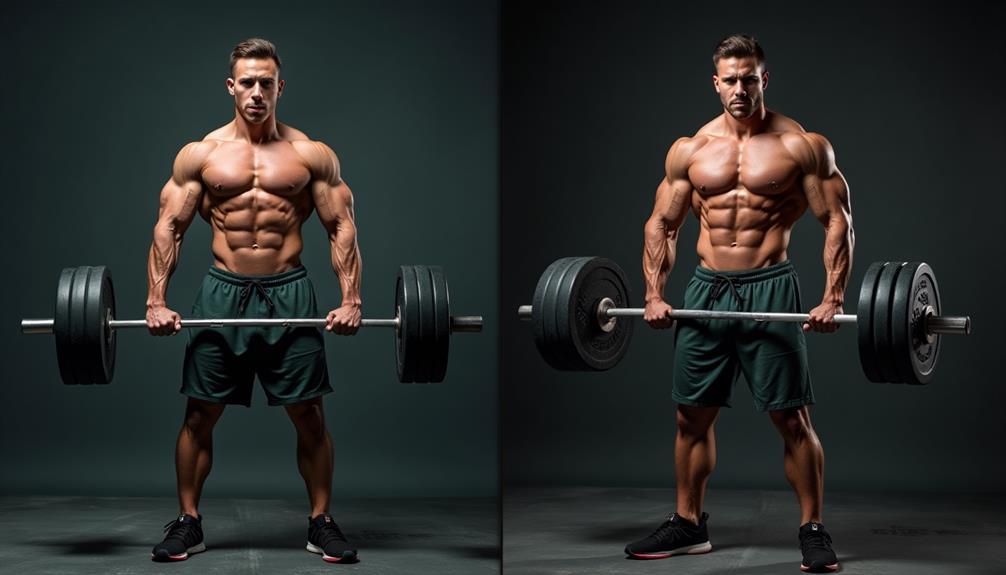Strength training focuses on lifting heavier weights with lower repetitions, promoting muscle strength and neural adaptations. It typically includes compound exercises like squats and deadlifts. In contrast, hypertrophy training emphasizes moderate weights and higher repetitions—around 6 to 12 reps—aiming to increase muscle size. The volume is higher in hypertrophy programs, with shorter rest periods of 30 to 90 seconds. Both methods serve distinct goals; strength is about lifting capacity, while hypertrophy targets muscle growth. Understanding these differences helps you tailor your workouts effectively, leading to better results. You might find even more insights on optimizing your training strategy.
Core Insights
- Strength training emphasizes lower repetitions (1-5) with heavier weights, while hypertrophy training focuses on moderate repetitions (6-12) for muscle growth.
- Strength training aims to maximize weight lifted, whereas hypertrophy training targets increases in muscle size through higher volume.
- Rest periods in strength training are typically longer (2-5 minutes) compared to shorter rest intervals (30-90 seconds) in hypertrophy training.
- Compound movements are prioritized in strength training, while hypertrophy training often includes a mix of compound and isolation exercises.
- The primary goal of strength training is to enhance neural adaptations, while hypertrophy training focuses on stimulating muscle growth.
Definition of Strength Training

Typically, you'll focus on lower repetitions with heavier weights. This approach encourages your muscles to adapt and grow stronger. Incorporating compound movements, such as squats and deadlifts, can enhance overall muscle engagement. For best results, consider investing in a quality power rack to safely perform these exercises at home. By consistently challenging your body, you'll not only see improvements in strength but also in overall fitness. Remember, proper form and technique are essential to prevent injuries.
Definition of Hypertrophy Training

Here's a quick overview of hypertrophy training characteristics:
| Feature | Hypertrophy Training | Strength Training |
|---|---|---|
| Rep Range | 6-12 reps | 1-5 reps |
| Weight Intensity | Moderate weights | Heavy weights |
| Rest Periods | 30-90 seconds | 2-5 minutes |
Primary Goals of Each Method

When it comes to training, understanding the primary goals of hypertrophy and strength methods can greatly influence your workout approach. Each method has distinct objectives that cater to different fitness aspirations.
- Hypertrophy Training: The main goal here is to increase muscle size. You focus on moderate weights with higher repetitions to stimulate muscle growth.
- Strength Training: This method emphasizes maximizing the amount of weight you can lift. You'll typically use heavier weights with lower repetitions to build strength.
- Functional Training: While not always a primary focus, this aims to improve overall athletic performance and daily functionality, often blending aspects of both hypertrophy and strength training.
Understanding these goals helps you tailor your training to meet your specific fitness needs and aspirations.
Training Volume and Intensity

The effectiveness of your training largely hinges on how you manage volume and intensity. Training volume refers to the total amount of weight lifted over time, while intensity relates to the effort you exert during your workouts. Balancing these two factors is pivotal for reaching your goals, whether for strength or hypertrophy.
| Factor | Strength Training | Hypertrophy Training |
|---|---|---|
| Volume | Lower (3-6 sets) | Higher (3-5 sets) |
| Intensity | Higher (80-90% 1RM) | Moderate (60-75% 1RM) |
| Focus | Neural adaptations | Muscle growth |
Repetition Ranges Explained

- Low Reps (1-5): This range primarily focuses on building strength. It involves lifting heavier weights with fewer repetitions, which enhances neural adaptations and power. This approach is often complemented by mass building supplements to support muscle recovery and growth.
- Moderate Reps (6-12): This range is ideal for hypertrophy, or muscle growth. It strikes a balance between weight and volume, promoting muscle fatigue and growth stimulation.
- High Reps (13+): Here, the goal shifts towards endurance. This range uses lighter weights with higher repetitions, improving muscular stamina and overall endurance.
Types of Exercises Used

Focusing on the right types of exercises is crucial for maximizing your training results, whether you're aiming for strength or hypertrophy. Kettlebells for strength can be an excellent addition to your workout routine, offering versatility and effectiveness for both strength and hypertrophy goals.
For strength training, prioritize compound movements like squats, deadlifts, and bench presses. These exercises engage multiple muscle groups and allow you to lift heavier weights, enhancing overall strength.
On the other hand, hypertrophy training benefits from both compound and isolation exercises. While compound lifts are still crucial, adding exercises like bicep curls or tricep extensions can help target specific muscle groups for growth.
Incorporating a mix of both types guarantees you're not just building strength but also promoting muscle size. Tailor your exercise selection to your specific goals, and you'll see better results in your training journey.
Recovery and Rest Periods

While you might be excited to hit the gym again after a tough workout, understanding the importance of recovery and rest periods is essential for maximizing your strength and hypertrophy gains. Proper recovery helps your muscles repair and grow, ultimately enhancing performance. Here's a quick guide on how to manage your rest periods:
- Duration: For strength training, aim for 2-5 minutes between sets. This allows for efficient recovery of the nervous system.
- Frequency: Incorporate at least 48 hours of rest before targeting the same muscle group again. This prevents overtraining and encourages growth.
- Active Recovery: On rest days, consider light activities like walking or stretching. This promotes blood flow without straining your muscles.
Long-term Adaptations and Benefits

| Adaptation Type | Strength Training |
|---|---|
| Muscle Fiber Size | Minimal increase |
| Neural Efficiency | Significant improvement |
| Bone Density | Greater increase |
| Functional Strength | Enhanced |
On the other hand, hypertrophy training leads to increased muscle size and improved endurance. Both types of training develop your overall fitness, but they do so in different ways. It is crucial to balance these approaches to maximize benefits and achieve your fitness goals.
Frequently Asked Questions
Can Strength Training Improve Athletic Performance in Other Sports?
Yes, strength training can enhance your athletic performance in various sports. It builds muscle power, improves endurance, and boosts overall stability, helping you excel in activities like running, jumping, or any sport requiring explosiveness and agility.
How Does Nutrition Differ for Strength Vs Hypertrophy Training?
Nutrition's essential for both strength and hypertrophy, but your focus shifts. For strength, prioritize protein and overall calories to fuel high-intensity workouts. For hypertrophy, you might increase carbs to support muscle growth and recovery.
What Are Common Misconceptions About Strength Training?
Many folks think strength training's only for athletes or bodybuilders. You might believe lifting heavy will bulk you up, but it actually builds lean muscle and boosts metabolism, making it beneficial for everyone, not just the elite.
Are There Specific Age Considerations for Strength Vs Hypertrophy Training?
As time flows like a river, your age influences training choices. When you're younger, focus on hypertrophy; as you age, strength training becomes essential for maintaining muscle mass and overall health. Embrace both paths for balance.
Can I Combine Strength and Hypertrophy Training in One Program?
Yes, you can combine strength and hypertrophy training in one program. By incorporating varied rep ranges and exercises, you'll target both muscle growth and strength gains effectively, giving you a well-rounded fitness routine.

